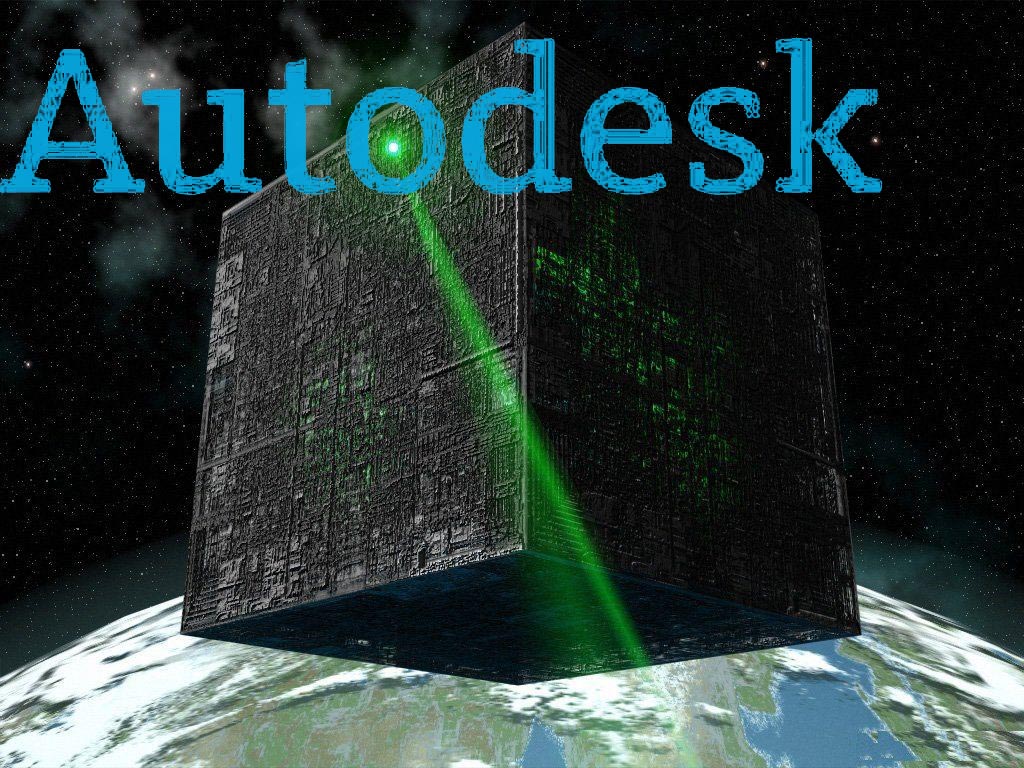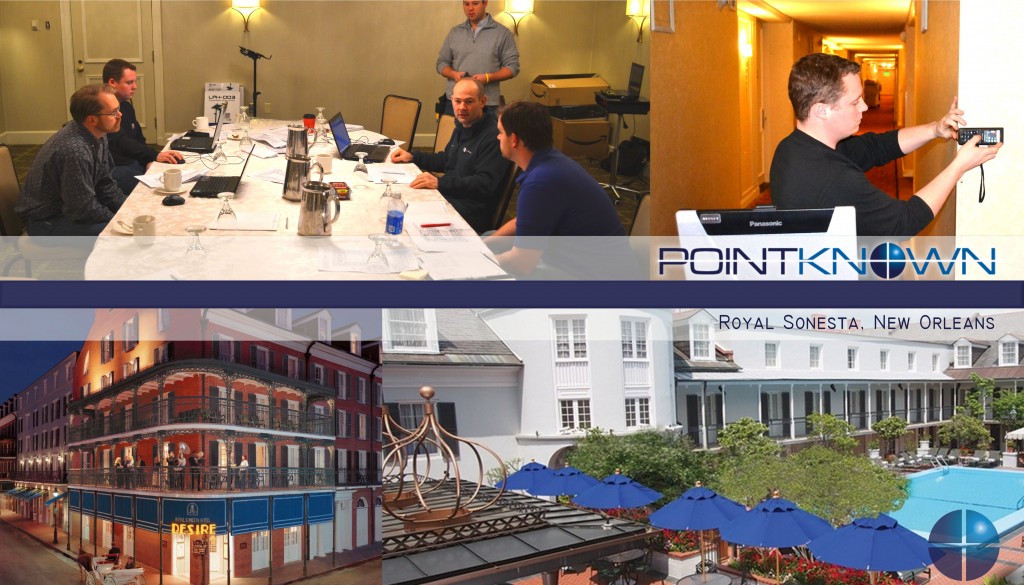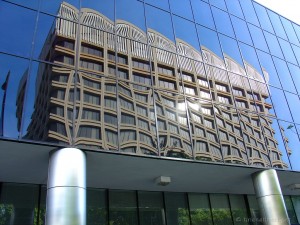Posts Tagged BIM
3 Myths About Laser Scanning and Point Clouds for Architecture and the Built Environment
Posted by Jim Foster in Built Environment, Laser Scanning, New Technologies, Point Cloud, Point to Point Laser Technology on September 16, 2013
Are laser scanners and their resulting pointclouds right for you and your project? As with all lists, it is simplified and of my opinion. Whether you want to trust my opinion, well that’s up to you, but my company Interioreview has, for over a decade, surveyed / drafted / modeled hundreds of buildings and starting in 2006 delivered Revit Models of existing buildings. My company, PointKnown, has created an Add-In to Revit that allows you capture and model buildings as you measure, in real time with a hand held laser. Now that I’ve blown my own horn here are my top 3 Myths:
It’s Foolproof and Error Free.
Wrong. I have not once received a model from a ‘pointcloud’ surveyor without dimensional errors in the model. Not once. Only because of our internal controls and surveying was I able to call out the errors and was not satisfied with other companies internal controls that the errors would have been found if my company had not found them. Such that we now will do all the modeling in house. Just because someone has a scanner does not mean they do it well.
it is concluded that features such as reflectivity, color, and brightness of the object surfaces have impact on the quality of the data, therefore, although 3D point cloud data is very useful it should be considered that the data can be sometimes irregular and corrupted and thus not exactly reflecting the features of the scanned object.
It’s Easy to Produce a Model From a Pointcloud.
Holy cow, no. How many technologies come into play to get a scan created, consolidated, registered, exported, modeled? First the hardware/scanner, whether it’s from Leica, Faro, whoever, they have their own software to manage the scan/cloud, and then you can export/import to Revit to use as a background to model over. You can use other technologies to help with this process such as Scan to BIM, or to cut portions of the pointcloud you can use ReCap, export to Autocad and re-import that data into Revit, etc. My point being there are a variety of methods to get from here to there but they are not necessarily consistent and have their strength and weaknesses, but you are using human power to make those decisions at each step. And then you are essentially using the pointcloud to ‘trace’ over. That is, you cut sections of the pointcloud in what ever view you are working in and trace over them. Has the person ‘modeling’ the building ever surveyed a building? Or have construction or architecture experience to know how a building should be put together. Does the architect really want to see a wall with a .08 degree deflection of wall off 90 degrees because it will create numerous amount of Revit errors, and was it really there or was the pointcloud interpreted incorrectly? There is no easy button.
It’s Cost Effective
Putting a scanning crew on site for a day is going to cost you between $3K-$4K typically, just to get the exterior of a building, with the pointcloud only, expect at least a 2 day buy in for between $6K and $8K, and that’s typically without going inside, and at the end you get the point cloud, not a Revit model. So a typical house, modeled from a point cloud, inside and out, best guess $8K-$10K. 12 Story Commercial Office Building, $50K+ and so on. Maybe that’s in your budget, but if so why? Why would you need to spend thousands of dollars to be told a room is square and has a 10′ ceiling?
Once dealing with the pointcloud, if you are dealing with it yourself, I hope you have a box/computer that is going to have a minimum of 16GB RAM, multicore XEON processor, etc. and ideally has a solid state drive, this is recommended by Autodesk for ‘pointcloud’ interactions.
You as a consumer of this data need to know what technologies are out there, your choices and their cost. I have seen circumstances and white papers where laser scanning pays dividends many times over, most consistently in existing exposed MEP intensive facilities, think utilities, drilling platforms, power-plants and the like where having a accurate representation of all that data can allow people to retrofit power-plants with few change orders or zero defects. Imagine an offshore construction platform that can lease for $100’s of thousands a day finishing early because of the accuracy of data, very good investment indeed even if it costs $200K to model it accurately. However, do you need that kind of data for a commercial building or an adaptive reuse project? How are you going to capture the interiors? There are methods to capture the built environment accurately for your needs without wasting money and effort.
Conclusion
Start with the simplest model you need, dimensionally accurate, volumetrically correct using whatever technology that gets you there cost effectively and with a level of confidence. Adding details to the model should be done dependent on scope and need. Power-plant of a building, you may want to bring in a scanner to model the piping package, etc. Accuracy of a historic structure that you may need to impact because of a project, sure scan it, but to scan an entire project is overkill in many circumstances no matter what you are told. Scan where you need details added. Know your options. Your tool box needs more than a hammer.
Freezing the Federal Footprint #gsa #bim
Posted by Jim Foster in BIM, GSA on May 22, 2013
 The Subcommittee on Economic Development, Public Buildings and Emergency Management meets this morning to discuss ‘Freezing the Federal Footprint’. This comes from an Office of Management and Budget memorandum that stated “ all Chief Financial Officers (CFO) Act Executive Branch departments and agencies (agencies) shall not increase the total square footage of their domestic office and warehouse inventory compared to the FY 2012 baseline.”
The Subcommittee on Economic Development, Public Buildings and Emergency Management meets this morning to discuss ‘Freezing the Federal Footprint’. This comes from an Office of Management and Budget memorandum that stated “ all Chief Financial Officers (CFO) Act Executive Branch departments and agencies (agencies) shall not increase the total square footage of their domestic office and warehouse inventory compared to the FY 2012 baseline.”
The memorandum also states that “Each agency should work collaboratively with other agencies and GSA to find opportunities for smarter space usage through co-locations and consolidations.” Ha ha ha, woooha, maybe it doesn’t mean anything, and I can’t say how much power a memorandum has vs. an office action, vs. an order but certainly can effect those depending on the largess of the GSA for a living. One wonders if the GSA ever moved forward with the GSA BIM IDIQ, that could have given them a solid assessment of properties they have etc. BTW did anyone ever make a dime off that? I found out the hard way that getting the award and having it funded are tow different things, so I guess it looks good in a frame.
Architectural, Engineering, and Related services: Top 5 Fastest Growing Industry For Small Business
Posted by Jim Foster in BIM on April 3, 2013
 A recent article in Entrepreneur Magazine, has Architectural Engineering and related services in the Top 5 Growth Industries for Small Business with growth pegged at 11.4%, #1 was Residential Building Construction. Now this has to be year to year growth but that factor was not mentioned in the article. It also is not so surprising considering the complete ass kicking these industries saw 2008-2010. However, it is encouraging because if the AE portion of AEC is busy, and stands to reason Construction is either in lockstep or not far behind. And this AEC ship is a big one and carries lots of people.
A recent article in Entrepreneur Magazine, has Architectural Engineering and related services in the Top 5 Growth Industries for Small Business with growth pegged at 11.4%, #1 was Residential Building Construction. Now this has to be year to year growth but that factor was not mentioned in the article. It also is not so surprising considering the complete ass kicking these industries saw 2008-2010. However, it is encouraging because if the AE portion of AEC is busy, and stands to reason Construction is either in lockstep or not far behind. And this AEC ship is a big one and carries lots of people.
Gehry Gets Into The Box : GTeam and BOX AEC Collaboration : #BIM #AEC
Posted by Jim Foster in BIM on February 26, 2013
 LOS ALTOS, CA–(Marketwire – Feb 14, 2013) – Sales in this (AEC) segment more than doubled over the course of 2012. Box today announced a new technology partner and preferred Box OneCloud apps to better serve customers in architecture, engineering and construction (AEC) services. The new integration with Gehry Technologies‘ GTeam cloud-based BIM collaboration service, together with the company’s extensive mobile ecosystem, will make it easier for Box’s growing AEC customer base to securely access, manage and share critical information like blueprints, CAD files and contracts in the field. Sales in this segment more than doubled over the course of 2012.
LOS ALTOS, CA–(Marketwire – Feb 14, 2013) – Sales in this (AEC) segment more than doubled over the course of 2012. Box today announced a new technology partner and preferred Box OneCloud apps to better serve customers in architecture, engineering and construction (AEC) services. The new integration with Gehry Technologies‘ GTeam cloud-based BIM collaboration service, together with the company’s extensive mobile ecosystem, will make it easier for Box’s growing AEC customer base to securely access, manage and share critical information like blueprints, CAD files and contracts in the field. Sales in this segment more than doubled over the course of 2012.
This whole cloud based AEC collaboration, especially with digital punch lists, central BIM files, etc. just seems to make too much sense for anyone to ignore.
Why the cats in the box, well, the interweb loves cats.
We Now Have The Time and Inclination To Do Things Right : BIM Adoption Reaches 71% In North America
Posted by Jim Foster in Adoption, BIM on February 13, 2013
 “We now have the time and inclination to do things right,” this phrase was uttered by a client of ours, a construction manager, after the 2008 economic implosion of the real estate sector. The time portion was meant ‘unfortunately’ as few of us were as busy as we wanted, but what he was referring to was his firms move to Revit/BIM. It just did not make sense from a coordination or phasing point of view to work in CAD anymore because he saw the savings and potential advantages for his firm to move to Revit.
“We now have the time and inclination to do things right,” this phrase was uttered by a client of ours, a construction manager, after the 2008 economic implosion of the real estate sector. The time portion was meant ‘unfortunately’ as few of us were as busy as we wanted, but what he was referring to was his firms move to Revit/BIM. It just did not make sense from a coordination or phasing point of view to work in CAD anymore because he saw the savings and potential advantages for his firm to move to Revit.
Now according the latest Smart Market Report from McGraw Hill BIM Adoption in North America has reached 71%; that’s up roughly 300% from 2007 when it was 28%. Give or take a few percentage points.
“I think there’s going to be a huge shakeout. Those who practice the old way are soon going to find themselves without work. Either change, get with this program or go out of business.” -Patrick MacLeamy, CEO HOK
Strong words, and I can’t say that the legacy tail of 2D is not a long one but the benefits of BIM are real, and if the reasoning for a firm not to make the move is simply, well we’ve always done it this way. It may be time to initiate a new planning regimen. Also in this report is information provided by JC Cannistraro, a MEP Constractor in Watertown, MA wqhich saw change orders drop from 18.42% when working with 2D CAD, to 2.68% with collaborative BIM, that’s as a percentage of total cost, and very real money.
Reality Capture, for Real. Autodesk Completes Capture of Allpoint Systems : #BIM
Posted by Jim Foster in BIM, Built Environment, New Technologies on February 7, 2013
 At the end of this month Autodesk announced it completed the purchase of Allpoint Systems, this adds to the ‘Reality Capture’ stable now including Alice Labs. Although much like the borg, you google Alice Labs and not much comes up as the technology and seemingly most of the talent has been absorbed into the mothership. As with the purchase of Alice Labs it does not appear that anything from Allpoint will be available for purchase anymore as the technology is incorporated into existing Autodesk products. From the Press Release:
At the end of this month Autodesk announced it completed the purchase of Allpoint Systems, this adds to the ‘Reality Capture’ stable now including Alice Labs. Although much like the borg, you google Alice Labs and not much comes up as the technology and seemingly most of the talent has been absorbed into the mothership. As with the purchase of Alice Labs it does not appear that anything from Allpoint will be available for purchase anymore as the technology is incorporated into existing Autodesk products. From the Press Release:
The acquisition of Allpoint Systems reflects Autodesk’s continued investment in developing sophisticated, easy-to-use reality capture technologies. Reality capture is the practice of creating digital models of physical objects and spaces using photography, laser scanning and other technologies.
Why ‘Reality Capture’ or the ‘Documentation of Reality’, well let’s talk about cars, hang with me. According to our good friends at Wikipedia, there are about 254 Million passenger cars on the road or registered in the United States and compared to new car sales of almost 13 million that’s a rough ratio of 80/20, that is new versus used. Interestingly, last time I pulled numbers and the Boston Redevelopment Authority of new construciton permits vs permits for improvements etc. in existing space it was 80/20, in favor of the existing space. So, look where the work is done, used cars, maintenance, improvements, after market, selling gas, same for buildings, infrastructure (bridges, tunnels) etc. And the best way to start a project is to document building, bridges, etc. accurately. The smart money buys used. Or let’s have Autodesk PR Recap. “….continued investment in developing sophisticated, easy-to-use reality capture technologies”
5 Firms Converge on New Orleans to Document The Royal Sonesta
Posted by Jim Foster in 3D, As Builts, BIM, Built Environment, Existing Conditions on January 16, 2013
 “Jim your a go….” 2:40 PM, New Years Eve 2012. Text from our client; Mark at Looney & Associates
“Jim your a go….” 2:40 PM, New Years Eve 2012. Text from our client; Mark at Looney & Associates
Our work window was January 3rd through January 9 2013. Travel arrangements and team needed to be assembled for flights in two days. The only thread holding this together was PKNail Pro.
Team members included individuals from Langan Engineering, Turis, TrueScan3d, LandAir Surveying and my company Interioreview. The Job: Survey and Document Floors 2-7 of the Royal Sonesta Hotel, 300 Bourbon Street. Include structure, electrical objects (Duplex, Com Ports, Thermostats, Wall Lights, etc) and Fire Protection. 450+ Rooms, Common Spaces, Administrative Spaces, +200,000 SF. 1 Week. From Blank Screen to Floorplans and RCP.
“This is innovative stuff…”, Greg Jensen, Langan Engineering
“…Boom, your done.” Brady O’Brien, Turis Systems
“This certainly opens the door for future teaming efforts, and we’ve already begun to push PK Nail on some of our interior projects – integrating it with scanning and traditional survey.” – Paul Fisher, VP Langan Engineering.
This project could not have happened without the participating firms willingness to deal with such a tight deployment deadline and with the excellent individuals that arrived in New Orleans. It also could not have happened, and I do have a horse in this race, without PKNail Pro and Revit. There was simply no other way to coordinate multiple personnel field surveying without both. We were able to deploy resources as needed since everything was being surveyed and modeled in real time. 4th Floor, South Wing, Greg get on it. Brian, 2nd Floor with Nico etc. This also allowed us to create a punch list in real time. Reflected Ceiling on 3rd Floor, etc. as all the files were compiled daily, if not more often into a central file. Although the deliverable will eventually be in 2D Autocad, all the initial documentation will be in Revit, so even though it was not part of the scope, we will be able to deliver a typical section through the building with only a small post processing effort.
Lastly, thank you to the good folks at The Royal Sonesta, New Orleans for treating us so well. They understand hospitality and have a great team.
More and more firms are relying on PKNail Pro for documenting buildings whether they need the final deliverable in Revit or 2D Autocad. PKNail Pro can deliver.
Adopting New Technologies and Business Practices : When’s a good time?
Posted by Jim Foster in Adoption, BIM, New Technologies on December 21, 2012
 Is there ever a good time to adopt a new technology or business practice? No. Yes. Today. First, ask yourself these questions, “Will it make me or our organization more profitable? Will it lead to new business opportunities?” One broad way to measure profitability is ROI in the investment. How much will it cost to introduce a new technology or business practice, what costs are involved, how quick is the pay back. Are there metrics in place to measure this? One can argue during downtime or between large projects is the best time to invest so they can be incorporated from the beginning of the next project. Cost center issues get caught up with the CFO or whatever other gate keeper that is out there because they cannot be assigned or passed on to a client. Why is this an argument? It might not be said out right, but this type of accounting is just easier and no one ever gets in trouble going with the flow. You were not the one who approved such expenditures so it can be pinned on you. Be an evangelist. Things need to get done. If there is a better way to do it. Do it. You know eventually your competition is going to and will either be A) more profitable B) more efficient or both and start making money at a lower cost than you are. You’re an artist, and it’s always worked this way. Okay, maybe, but that doesn’t scale. The organization is you. And maybe that’s okay but I don’t know how you hire and keep talented people. People like to solve problems and they want the tools to solve them. You have to build a house. Tough to argue for the hammer over the nail gun.
Is there ever a good time to adopt a new technology or business practice? No. Yes. Today. First, ask yourself these questions, “Will it make me or our organization more profitable? Will it lead to new business opportunities?” One broad way to measure profitability is ROI in the investment. How much will it cost to introduce a new technology or business practice, what costs are involved, how quick is the pay back. Are there metrics in place to measure this? One can argue during downtime or between large projects is the best time to invest so they can be incorporated from the beginning of the next project. Cost center issues get caught up with the CFO or whatever other gate keeper that is out there because they cannot be assigned or passed on to a client. Why is this an argument? It might not be said out right, but this type of accounting is just easier and no one ever gets in trouble going with the flow. You were not the one who approved such expenditures so it can be pinned on you. Be an evangelist. Things need to get done. If there is a better way to do it. Do it. You know eventually your competition is going to and will either be A) more profitable B) more efficient or both and start making money at a lower cost than you are. You’re an artist, and it’s always worked this way. Okay, maybe, but that doesn’t scale. The organization is you. And maybe that’s okay but I don’t know how you hire and keep talented people. People like to solve problems and they want the tools to solve them. You have to build a house. Tough to argue for the hammer over the nail gun.
One business proverb always comes to mind when dwelling on this issue.
“If you don’t like new technology you’ll like obsolescence even less.”
Next Time: “It’s all Organization Behavior”
Hey Microsoft I’ve Got Your Game Changer; Right Here
Posted by Jim Foster in BIM, New Technologies, Revit on October 24, 2012
 So when we demo our software, inevitably for a lot of architects we are asked, usually at least once, so will this work on the ipad? Fact is, not yet, not until Revit works on the ipad, which the only way I see that happening is that Citrix does an amazing job serving it through a 4G pipeline, so most likely Revit / BIM Models can be viewed in the field, but not yet interacting with one in a meaningful way. Yes you might argue there are check lists, etc. but I’m speaking about dealing with the actual authoring tool. So while architects ask if PKNail Pro works on the ipad. Salespeople will say, “Hey have you seen the Surface? That could be a game changer for you.” That is full blown windows working on a tablet that will run Revit in the field. The review by David Pogue in the Times, states the Surface “On the hardware front, Microsoft has succeeded brilliantly… amazing, amazing hardware. Now the heartbreak: software.” He argues that operating system is not here yet, but this is Windows RT. I’m talking about taking Full Blown Windows into the field for some serious heavy weight mobile application throw down. Building a Revit Model, a Building Information Model of an existing building, in the field, in real time with just your Surface Tablet, a laser range finder, and some software, some industry specific software that will make you 10x faster. Yes, I’m saying PKNail Pro will do that. It’s effective, it’s fast, and now let’s put a wrapper around it named Surface.
So when we demo our software, inevitably for a lot of architects we are asked, usually at least once, so will this work on the ipad? Fact is, not yet, not until Revit works on the ipad, which the only way I see that happening is that Citrix does an amazing job serving it through a 4G pipeline, so most likely Revit / BIM Models can be viewed in the field, but not yet interacting with one in a meaningful way. Yes you might argue there are check lists, etc. but I’m speaking about dealing with the actual authoring tool. So while architects ask if PKNail Pro works on the ipad. Salespeople will say, “Hey have you seen the Surface? That could be a game changer for you.” That is full blown windows working on a tablet that will run Revit in the field. The review by David Pogue in the Times, states the Surface “On the hardware front, Microsoft has succeeded brilliantly… amazing, amazing hardware. Now the heartbreak: software.” He argues that operating system is not here yet, but this is Windows RT. I’m talking about taking Full Blown Windows into the field for some serious heavy weight mobile application throw down. Building a Revit Model, a Building Information Model of an existing building, in the field, in real time with just your Surface Tablet, a laser range finder, and some software, some industry specific software that will make you 10x faster. Yes, I’m saying PKNail Pro will do that. It’s effective, it’s fast, and now let’s put a wrapper around it named Surface.
So Microsoft, send me a demo, if it’s what I’m expecting I’ll be singing your praises. It’s time to get to work.
*I’m serious Microsoft, so hopefully an identity manager has picked this thread up, or someone wants to make introduction. We are fired up for the Surface and not because we want swag but because it looks like its the size of a beach ball, teed up, and we’re swinging hard.
**Why a picture of LT? Well, it’s LT. Further defined: Left Offensive Tackles are now prized possessions in the NFL and some of the highest paid. That happened when LT lined up. LT changed the game.
When BIM Falls Down : Call Me Maybe : It’s Communication
Posted by Jim Foster in BIM on October 3, 2012
 There was a headline grab, “Late-Arriving BIM Model,Overruns Cost US Almost $10 Million” a few days back. I’d include the link through ENR but it’s already dead and only for paying customers. But who or what actually fell down? Did the lateness of the model cause the cost over runs? Was it a lousy model? However, that prompts the question, or search “BIM Lawsuit“, and you know what,you do not get back many results. The article BIM Offers Cautionary Tale from the Architectural Record comes up first and is from May 19, 2011. A few bits from the article:
There was a headline grab, “Late-Arriving BIM Model,Overruns Cost US Almost $10 Million” a few days back. I’d include the link through ENR but it’s already dead and only for paying customers. But who or what actually fell down? Did the lateness of the model cause the cost over runs? Was it a lousy model? However, that prompts the question, or search “BIM Lawsuit“, and you know what,you do not get back many results. The article BIM Offers Cautionary Tale from the Architectural Record comes up first and is from May 19, 2011. A few bits from the article:
“The contractor sued the owner, the owner sued the architect, and XL brought in the MEP engineer. “It was a very costly claim to negotiate,” says Lewis. XL(the insurance company) did not litigate the claim because it would be difficult for any jury to comprehend.
But more importantly:
The problem was poor communication. “The design team never discussed the installation sequence with the contractor, and the contractor wasn’t sophisticated enough” to understand the importance of assembling the components in a certain order, says Lewis.
So quick over view, it was communication, not the model, but overall insight, we’ve got one law suit coming up and it was settled in May 2011, how long has BIM been around? So that seems like a pretty good track record, or awesome legal representation and contractual agreements, or what? Fast forward to this latest article and it still seems to be a communication and coordination problem, the BIM was provided late, the clash detections were late, and it seemed no one wanted to take responsibility for the development of the a ‘clash free’ model. Now I am doing this by memory since I got one read in, linked it and now its gone so please forward a link or copy if you have one. However, it comes down to communication, one still sees the power of BIM and the fact that it unearthed 50K+ clashes, still digitally so not sure if the cost over runs were due to change orders and time delays or redoing the whole BIM model. What does this scream though, “it’s the process people.”
In most cases each contractor is going to work within their particular area of expertise and provide said BIM Model to the level of detail that they are contractually obligated to, in fact, I’ve been asked to do a Revit Model for a just built building because it was required at the end of the project, they wanted it for short money, tail light guarantee, just so they could check off a box. Not necessarily what the process was supposed to be about, but they were filling their obligation.
The ratio of BIM Success v. BIM Cautionary Tale is 143,238.2 to 1, but I can see where the cautionary tale makes people question the technology? Wrong. Question the process


